|
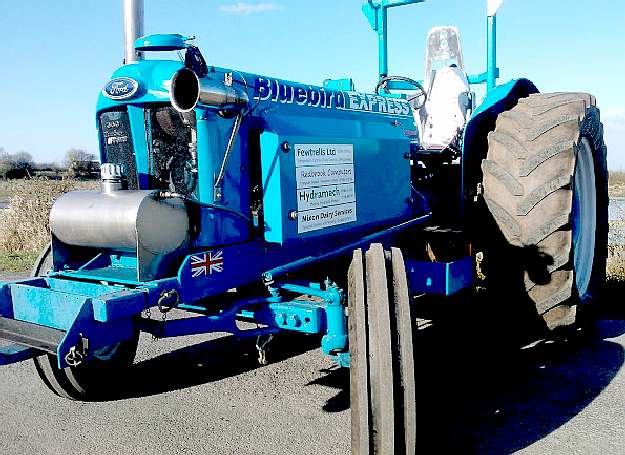
The
"Bluebird Express" is a Ford tractor that has been honed by Mark
Fewtrell (owner and driver) into a serious bit of pulling kit. The
team got into their second year in 2013 and still felt pretty new to the sport,
saying they have a lot to learn. They are though tackling the sport in a
practical manner befitting farming gentlemen and formula one techies
alike, by adding such trinkets as a data logger to take stock of the mound
of melted components in digital terms. That gave them facts and figures to
compare as opposed to hunches when divining their forward agenda. 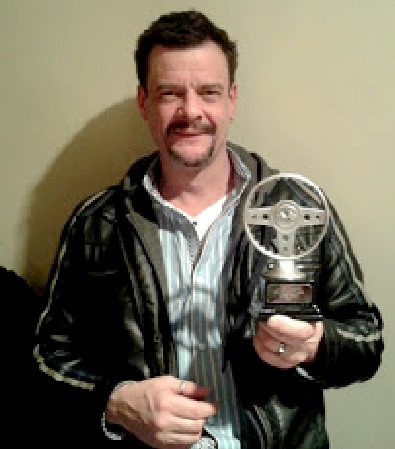

Mark
Fewtrell is the driving force behind team Bluebird Express 
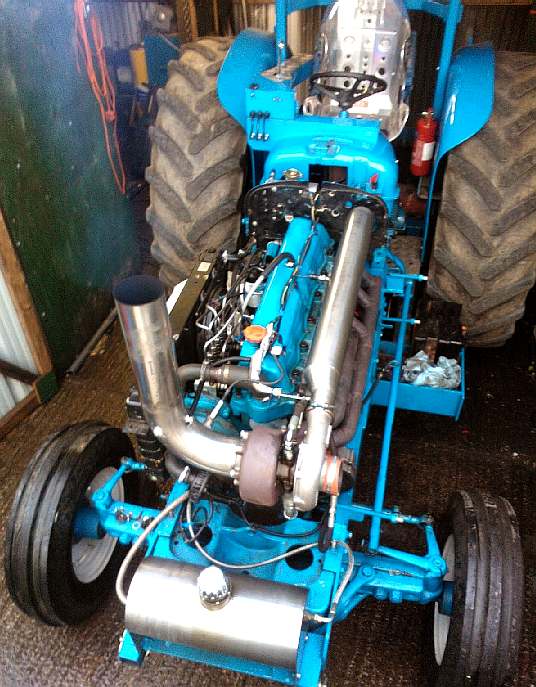
High
back ally (above left) seat and a data logger (below left) 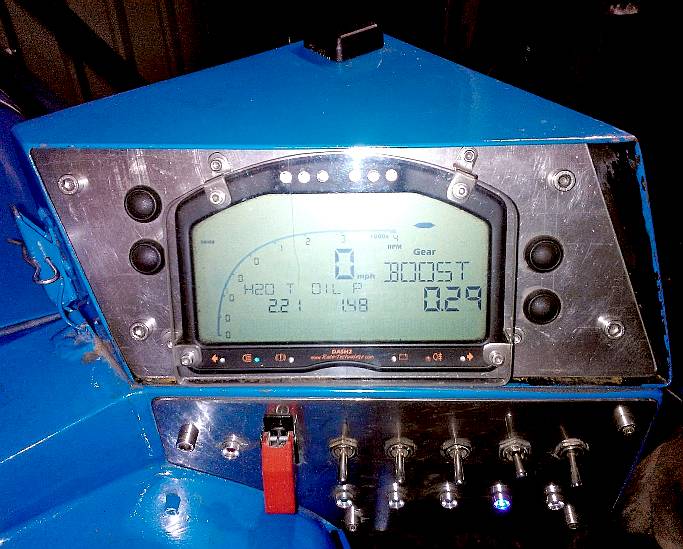
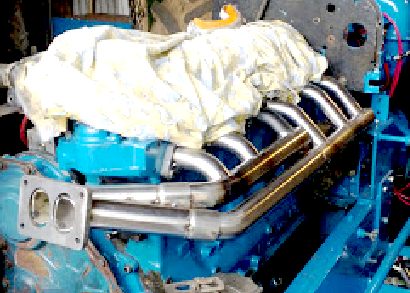
ABOUT
TRACTOR PULLING Truck and Tractor pulling, also known as power pulling, is a motorsport competition, popular in
the United States, Europe (especially in the Netherlands), Australia and Brazil, which requires modified tractors to pull a heavy sledge (sled) along a 35 ft wide and length of 100 meters or 300
feet + track, with the winner being the tractor that pulls the sledge farthest. The sport is known as the world's most powerful
motorsport, due to the multi-engined modified tractor pullers.
All tractors in their respective classes pull a set weight in a sledge. When a tractor gets to the end of the
300 feet track this is known as a "full pull". When more than one tractor completes the course, more weight is added to the sledge, and those competitors that went past 300 feet will have a
pull-off in a second and third heat; the winner is the one who can pull the sledge the longest.
The sledge is known as a weight transfer sled. This means that as it is pulled down the track, the weight is transferred (linked with gears to the sledge’s wheels) from over the rear axles and towards the front of the sledge. In front of the rear wheels, there is a "pan". This is essentially a metal plate and as the weight moves over this the resistance builds. The further the tractor pulls the sledge, the harder it gets.
The most powerful tractors, such as those in the 4.5 modified class in Europe, can produce over 10,000 bhp.
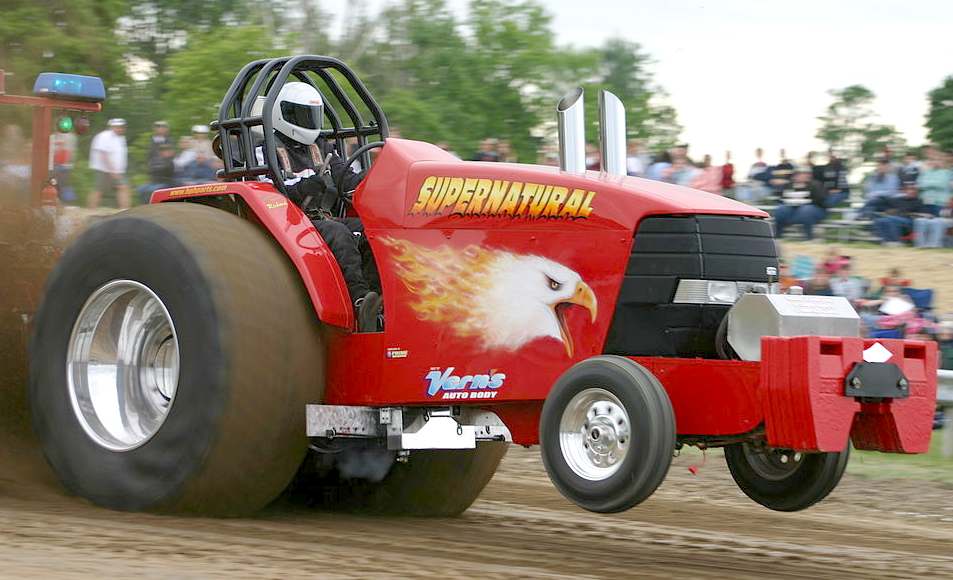
US HISTORY
It is said that around the 1860s when farming machines were pulled by horse, farmers would boast about the strength of their horses. They would claim that their horse could tow large loads, such as a fully loaded hay cart or wagon. Farmers would challenge one another to contests to prove who had the strongest horse. A barn door was removed and laid flat on the ground, and the horse was then hitched to it; the farmer would then urge the horse to drag the barn door along the ground. One by one, people jumped on the door until the horse could no longer drag it; the horse pulling the most people the greatest distance was judged the strongest. This event, called horse pulling, is still carried out today with specially bred horses trained to have high strength and low stamina, rather than low strength and high stamina which is normally the case with racing horses. Instead of people, fixed weights on sleds are dragged as far as possible. While it is said that the term horsepower is derived from this event, in reality the term was coined by James Watt.
It wasn't until 1929 that motorized vehicles were put to use in the first events at Vaughansville, Missouri, and Bowling Green,
Ohio, the latter being where the current national championships are held. Although the sport was recognized then, it did not really become popular until the '50s and '60s. It was also realized, at that time, there were no uniform set of rules. The rules varied from state to state, county to county, and competitors never knew what standards to follow. This made the sport difficult for new entrants.
In 1969, representatives from eight states congregated to create a uniform book of rules to give the sport the much needed structure, and created the National Tractor Pullers
Association (NTPA). The NTPA's early years were events that used standard farm vehicles, with the motto "Pull on Sunday, plow on Monday". Pulling remained basically the same through the '70s, with only stock and modified tractors. Stock tractors were commercially available tractors produced by manufacturers, and modified tractors were the basic tractor chassis with another non-tractor engine mounted on it.
Tractors remained single engine until two Ohio brothers, Carl and Paul Bosse, introduced the crossbox which could allow multiple engines to be attached to a single driveshaft. Other innovators during this period included Bruce Hutcherson, with his triple Rodeck engine powered "Makin Bacon Special", Dave and Ralph Banter and their Chevrolet powered tractors, and the "Mission Impossible" tractors of Tim Engler, which at one point had up to seven blown alcohol engines on board.
Subsequently, modified tractors with four engines were common, while stock tractors tried to catch up by adding multiple large turbochargers, along with intercoolers, but both retained the appearance of a tractor. Soon tractors became single-use machines that were not used on the farm, making the "Pull on Sunday, plow on Monday" motto obsolete.
Throughout the '70s and '80s the modified division continued to thrill crowds by adding more engines, and soon the tractors lost their tractor appearance and turned into high 'spec' dragsters. The limit was reached in 1988 when a tractor with seven engines was built. As well as piston engines, jet engines appeared in 1974, with Gardner Stone's "General" Tractor a four-jet-engined unit hitting the hook in 1989.
The growing popularity of the sport caused the creation of a new four-wheel drive division in 1976, which captured a large fan base. The engine sizes in these vehicles continued to increase, from 450 cubic inches/7.3 liters up to 700/11.5 and probably would have continued, but the NTPA limited it to 650/10.6 naturally aspirated and no blown engine in 1989. Today the 4-wheel drive division is one of the most popular with the success of trucks like the Holman Brothers "4-Play" Chevy and Bob Boden's
"Studley Studebaker".
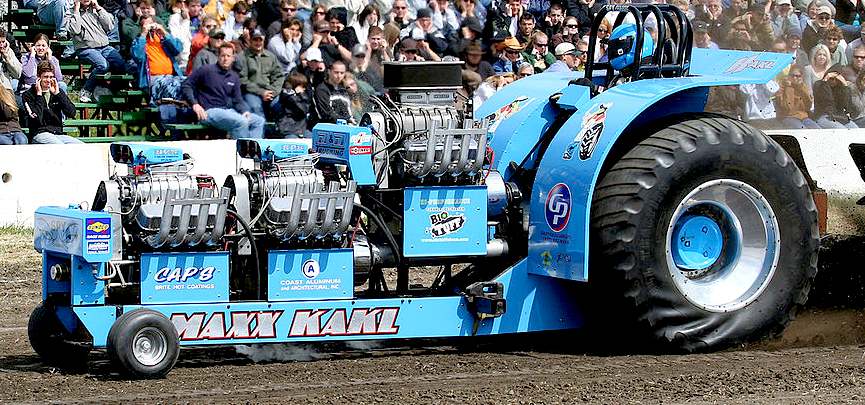
TWO WHEEL DRIVE (2WD)
TRUCK CLASS
The two-wheel drive (2WD) or "funny car" division was introduced in 1986.
The division imposes a weight-limit of 6,200 pounds on each competing truck, a maximum width of eight feet, and a maximum distance of 15 feet from the centerline of the rear axle to the front of the vehicle (including weight racks and tow hook). (The length restriction allows for up to ten inches of cosmetic
fiberglass, however.)
Gasoline engines with up to eight cylinders are permitted, but diesel engines are not. Any wheelbase is permitted.
The National Tractor Pullers Association restricts engines to 575 in3 and two valves per cylinder. They permit tubular steel frames. The maximum tire size for the 2WD class is 18.4 x 16.1, with a maximum circumference of 143 inches when mounted on an 18-inch-wide rim and inflated to 28 psi. The ground patch is not to exceed 19 inches on original tread.
SUPER STOCK PRO
AND MINI MODIFIED
Super Stock Open class uses primarily methanol fuel (some are diesel versions). The Super Stock Open machines can generate over 5,000 horsepower. Super Stock tractors may use up to four turbochargers in three stages.
Pro Stock Tractors are limited to one turbocharger and diesel fuel is the only allowable source for power, in keeping with the 'spirit' of the original tractors. Their engines reach the 3000 horsepower region.
The mini-modified class is a garden lawn mower mounted with a supercharged V8.
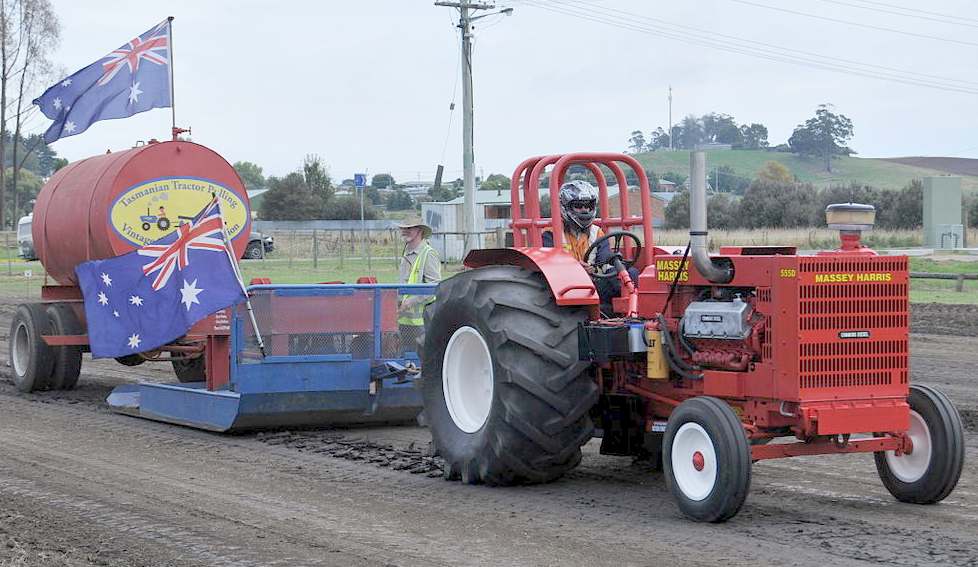
AUSTRALIA HISTORY
The first Australian Tractor Pull was held at the Elmore Field Days (Victoria) in 1976. The following year saw Tractor Pulling begin in the Victorian rural town of Quambatook. It has developed over the years into a highly competitive and technical sport, where the difference between first and last place may be as small as one or two metres. Often the top tractors are separated by mere centimetres.
The Australian Tractor Pullers Association (ATPA) is a non-profit organisation that governs Tractor Pulling in Australia. Our events (Tractor Pulls) are held in conjunction with a promoter. This is often a local school, sporting, service or community club (for example; Apex, Rotary, Lions, Netball, Cricket, Football) who use the event as a fundraiser. Tractor Pulls are held in locations throughout Australia, predominantly in Victoria, South Australia and New South Wales. In the west the Western Australian Tractor Pullers Association (WATPA) runs events and is affiliated with the ATPA.
The ATPA is focused on actively promoting this spectacular sport and working with communities to not only establish a unique annual event, but more importantly to assist communities financially through the influx of spectators, sponsors and promotion.
The tractors are divided into classes and comply with either "Limited" or "Open" rules. The classes are Open Modified, Super Modified, Limited Modified, Open Mini Modified, Mini Modified, Pro Stock (diesel) and Two Wheel Drive Trucks. The distinction between classes is determined by the overall maximum weight, engine modifications, fuels and physical size.
Competition is open to both women and men, the only restriction being that competitors must at least hold a current Learner Driver’s Permit. It sometimes comes down to members of the same family competing for the trophies.
The Junior Modified Pulling Association conducts an "introductory" class for 8- to 16-year-olds to develop driving, mechanical and competitive skills. The Modified Mowers pull their own smaller version of the big sled.
SLED PULLING
In the early days two main techniques were used. Either a dead weight of fixed mass was dragged, or the step-on method was used, where people stood at fixed positions and stepped aboard as the sled passed. Another rule which has now been dropped was that a speed limit should be observed because of injuries resulting from the increased speed at which they boarded. Today's tractors can achieve theoretical speeds over 125 mph.
Today's sleds use a complex system of gears to move weights up to 65,000 pounds/29,000 kilograms. Upon starting, all the weights are over the sled's rear axles, to give an effective weight of the sled plus zero. As the tractor travels the course, the weights are pushed forward of the sled's axles, pushing the front of the sled into the ground, synthetically creating a gain in weight until the tractor is no longer able to overcome the force of friction.To help stop the sled some sleds have grouser bars that act like teeth and dig into the soil to stop the sled.
ENGINE TYPES
Apart from modified standard diesel tractors, a variety of high power engines are used in tractor pulling, which started in the late 1970s. In the early years, mainly single, double or multiple US-made big block dragster engines were used, but nowadays, a lot of parts from discarded military machinery are in use, like Klimov TV3-117
(Isotov) turboshafts from Russian helicopters, Soviet Zvezda M503 torpedo boat engines, Continental AV1790 tank engines, or World-War-2-era aircraft piston engines in V12-shape (e.g. Rolls-Royce Griffon) or as radial engines (e.g. Curtiss-Wright R-3350). Due to the limited number of vintage warbird engines remaining, some organisations that own them, such as the Fantasy of Flight museum in Florida, refuse to sell engines from their collection to customers that wish to use them for tractor pulling. In recent years a number of agricultural engines have been converted to run on methanol with multi-stage turbocharging.
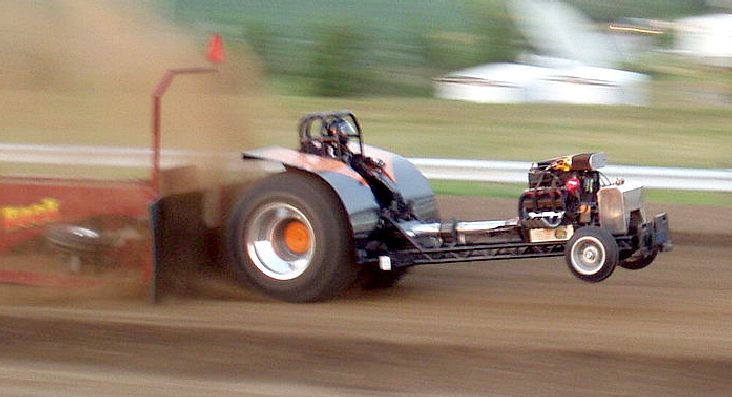
ORGANIZATIONS
US:
NTPA
– National
Tractor Pullers Association
PPL
– LUCAS
OIL Pro Pulling League
ITPA
– Illinois
Tractor Pulling Association
MSPA
– Mid-South
Pullers Association
MATPA
- Missouri-Arkansas
Truck Pulling Association
ESP
– Empire
State Pullers
WNYPFP
– Western
New York Pro Farm Pullers
NBP
– Nebraska
Bush Pullers
OSTPA
– Ohio
State Tractor Pullers Association
SPA
– Southern
Pullers Association
PAPA
- Piedmont
Antique Power Association
PTMTP
- Pine
Tree Mini Tractor Pullers Association
UTTPI
- United
Truck & Tractor Pullers
ATPA
- Adirondack
Tractor Pullers Association
NSPA
- National
Sled Pullers Association
Europe:
DTP
– Danish
Tractor Pulling
ETPC
– European
Tractor Pulling Committee
NTTO
– Netherlands
Truck- and Tractorpulling Organisation
DTTO
– German
Tractorpulling Organisation
TPI
– Tractor
Pulling Italia
FTPA
– Finnish
Tractor Pulling Association
BKTV
– Belgian
Power Tractor Organisation
FTPF
– Fédération
française de tracteur pulling
RTPA
– Tractor
Pulling Russia
UK:
BTPA
– British
Tractor Pullers Association
MTPC
– Midland
Tractor Pullers Club
NWTPA
– North
West Tractor Pullers Association
STPC
– Scottish
Tractor Pullers Club
Australia:
ATPA
– Australian
Tractor Pullers Association Inc.
MTPA
– Mini
Tractor Pullers Association Inc.
QTPA
– Quambatook
Tractor Pullers Association Inc.
WATPA
– West
Australian Tractor Pull Association
JMPA
– Junior
Modified Pulling Association
Other:
NR/CTPA
– National
Radio Control Truck Pulling Association
ABTT
– Associação
Brasileira de Trekker Trek / Brazilian Tractor Pulling Association
NSPA
– National
Sled Pulling Association
SPA
– Southern
Pullers Association
BTPA
– Badger
Truck Pullers Association
LINKS
Tractor_pulling
http://en.wikipedia.org/wiki/Tractor_pulling
http://www.expresstractorpulling.com/
http://www.expresstractorpulling.com/2013
Malpas
Tractor Pulling Club
Redline
Frenzy Tractor Pulling Team
Scottish
Truck and Tractor Pullers Association
South
West Tractor Pullers Association
|







